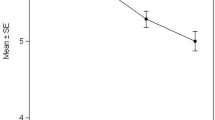Abstract
Retinol is widely used for topical application for antiaging. However, the efficacy and effect rate of different concentrations of retinol have been rarely analyzed. Therefore, in this study, the efficacy and rate of effect of retinol concentrations from 1500 to 6600 IU, on various skin parameters, have been compared. Seventy-two Korean women aged 40–59 years participated in this study. Retinol was used by them for 24 weeks; the effects were measured at 0, 2, 4, 8, 12, and 24 weeks. The measurement parameters for aging were crow’s feet, forehead wrinkles, nasolabial fold, dermal density, and elasticity and that for skin color were skin brightness, yellowness, redness, and standard deviation of skin brightness. The texture of the skin was measured by measuring the skin roughness and pores, and the skin barrier function was evaluated through hydration, sebum, and desquamation. Low concentration retinol (1500–2500 IU) had a significantly higher effect in skin color, brightness, and elasticity and faster improvement rate in skin brightness and elasticity compared to that for high concentration (3300–6600 IU). High concentration of retinol had a significantly higher effect in wrinkles, dermal density and pores and faster improvement rate for wrinkles, skin texture, pores, and desquamation compared to that for low concentration. This study evaluated the changes caused by different concentration of retinol over a long period of time. The results of this study have great implications as the optimal concentration of retinol can be prescribed for an accurate period for the desired results without side effects.




Similar content being viewed by others
References
Castenmiller JJ, West CE (1998) Bioavailability and bioconversion of carotenoids. Annu Rev Nutr 18:19–38. https://doi.org/10.1146/annurev.nutr.18.1.19
Blomhoff R, Green MH, Norum KR (1992) Vitamin A: physiological and biochemical processing. Annu Rev Nutr 12:37–57. https://doi.org/10.1146/annurev.nu.12.070192.000345
Olson JA (1989) Provitamin A function of carotenoids: the conversion of β-carotene into vitamin A. J Nutr 119(1):105–108. https://doi.org/10.1093/jn/119.1.105
Fisher GJ, Datta SC, Talwar HS et al (1996) Molecular basis of sun-induced premature skin ageing and retinoid antagonism. Nature 379(6563):335–339. https://doi.org/10.1038/379335a0
Fisher GJ, Wang ZQ, Datta SC, Varani J, Kang S, Voorhees JJ (1997) Pathophysiology of premature skin aging induced by ultraviolet light. N Engl J Med 337(20):1419–1428. https://doi.org/10.1056/NEJM199711133372003
Griffiths CE, Russman AN, Majmudar G, Singer RS, Hamilton TA, Voorhees JJ (1993) Restoration of collagen formation in photodamaged human skin by tretinoin (retinoic acid). N Engl J Med 329(8):530–535. https://doi.org/10.1056/NEJM199308193290803
Fluhr JW, Vienne MP, Lauze C, Dupuy P, Gehring W, Gloor M (1999) Tolerance profile of retinol, retinaldehyde and retinoic acid under maximized and long-term clinical conditions. Dermatology 199(suppl. 1):57–60. https://doi.org/10.1159/000051381
Lee MW (2020) The detrimental side effects of retinol: Beyond Beauty Products [theses]. Portland State University
Bellemère G, Stamatas GN, Bruère V, Bertin C, Issachar N, Oddos T (2009) Antiaging action of retinol: from molecular to clinical. Skin Pharmacol Physiol 22(4):200–209. https://doi.org/10.1159/000231525
Kligman AM, Willis I (1975) A new formula for depigmenting human skin. Arch Dermatol 111(1):40–48. https://doi.org/10.1001/archderm.1975.01630130042004
Griffiths CE, Finkel LJ, Ditre CM, Hamilton TA, Ellis CN, Voorhees JJ (1993) Topical tretinoin (retinoic acid) improves melisma. A vehicle-controlled, clinical trial. Br J Dermatol 129(4):415–421. https://doi.org/10.1111/j.1365-2133.1993.tb03169.x
Randhawa M, Rossetti D, Leyden JJ et al (2015) One-year topical stabilized retinol treatment improves photodamaged skin in a double-blind, vehicle-controlled trial. J Drugs Dermatol 14(3):271–280
Tucker-Samaras S, Zedayko T, Cole C, Miller D, Wallo W, Leyden JJ (2009) A stabilized 0.1% retinol facial moisturizer improves the appearance of photodamaged skin in an eight-week, double-blind, vehicle-controlled study. J Drugs Dermatol 8(10):932–936
Diridollou S, Vienne MP, Alibert M et al (1999) Efficacy of topical 0.05% retinaldehyde in skin aging by ultrasound and rheological techniques. Dermatology 199(1):37–41. https://doi.org/10.1159/000051377
Shao Y, He T, Fisher GJ, Voorhees JJ, Quan T (2017) Molecular basis of retinol anti-ageing properties in naturally aged human skin in vivo. Int J Cosmet Sci 39(1):56–65. https://doi.org/10.1111/ics.12348
Lee M, Han J, Kim E (2019) An evaluation of the effects of makeup on perceived age based on skin color in Korean women. J Cosmet Dermatol 18(4):1044–1051. https://doi.org/10.1111/jocd.12811
Stephen ID, Law Smith MJL, Stirrat MR, Perrett DI (2009) Facial Skin coloration affects perceived health of human faces. Int J Primatol 30(6):845–857. https://doi.org/10.1007/s10764-009-9380-z
Mercurio DG, Segura JH, Demets MBA, Maia Campos PMBG (2013) Clinical scoring and instrumental analysis to evaluate skin types. Clin Exp Dermatol 38(3):302–8; quiz 308. https://doi.org/10.1111/ced.12105
Leyden J, Grove G, Zerweck C (2004) Facial tolerability of topical retinoid therapy. J Drugs Dermatol 3(6):641–651
Funding
This research received no specific grant from any funding agency in the public, commercial, or not-for-profit sectors.
Author information
Authors and Affiliations
Contributions
Byung-Fhy Suh, Eunjoo Kim and Sue Im Jang conceived of the presented idea. Sue Im Jang, Yu-Chul Jung developed the theory and performed the computations. Yu-Chul Jung, Jangmi Suk, and Sieun Lee verified the analytical methods. Sue Im Jang, Jangmi Suk, Sieun Lee, and Jaeil Han to investigate and supervised the findings of this work. All authors discussed the results and contributed to the final manuscript
Corresponding author
Ethics declarations
Competing interests
The authors declare no competing interests.There are no relevant financial or non-financial competing interests to report.
Additional information
Publisher's Note
Springer Nature remains neutral with regard to jurisdictional claims in published maps and institutional affiliations.
Rights and permissions
Springer Nature or its licensor (e.g. a society or other partner) holds exclusive rights to this article under a publishing agreement with the author(s) or other rightsholder(s); author self-archiving of the accepted manuscript version of this article is solely governed by the terms of such publishing agreement and applicable law.
About this article
Cite this article
Jang, S.I., Jung, YC., Suk, J. et al. A long term study of the difference in efficacy and effect rate of various concentrations of retinol (1500–6600 IU) in middle aged women. Arch Dermatol Res 315, 1323–1332 (2023). https://doi.org/10.1007/s00403-022-02520-2
Received:
Revised:
Accepted:
Published:
Issue Date:
DOI: https://doi.org/10.1007/s00403-022-02520-2




